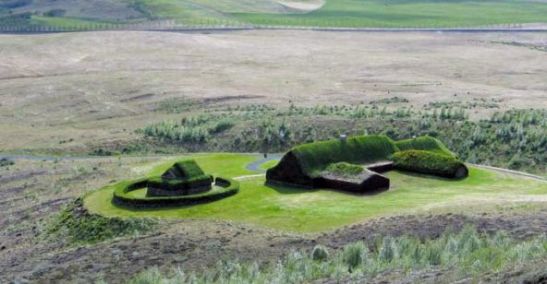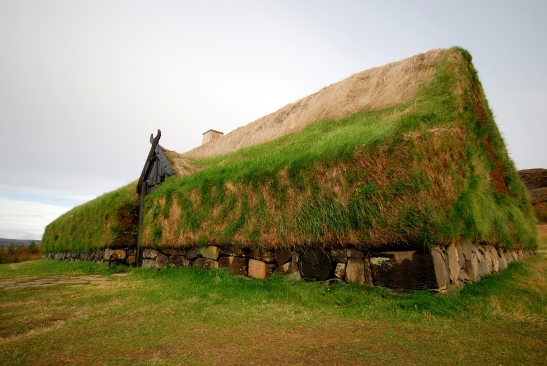‘Iceland’s Pompeii’: Þjóðveldisbærinn Stöng
In 1104 Iceland’s most famous volcano Hekla erupted, covering the local area with tephra and destroying an entire district of farm complexes in the Þjórsárdalur valley. Among them was the farmhouse named Stöng which was excavated in 1939 by a team of Nordic archaeologists. Buried under a thick layer of pumice the farmhouse was in a remarkable state of preservation, earning it the rather fanciful name of ‘Iceland’s Pompeii’.
The farmhouse was a basic longhall, seventeen metres long and six metres wide. The walls were wainscotted with a clear space between the panels and the thick turf walls to prevent rotting. Along the walls were raised platforms where people could sit to work and eat, or lie down to sleep. A lokrekkja or lockable bed-closet with panelled walls gave the head of the family and his wife some semblance of privacy in the otherwise open eldaskáli, or fire-hall. In the middle of the hall a long-fire provided heat. At the inner end of the hall a doorway led to a later extension which was used as a stofa, or living room, used primarily by the women as both a dwelling and work area. A sunken stone box in the floor provided a hearth. Sitting benches lined two walls and a kvennapallur, or women’s platform held an upright weaving loom and provided space underneath for the storage of textiles as they were finished. Weaving was essential, and backbreaking, work, essential to the economy of the farm with vaðmál, homespun cloth, a staple export commodity and also a main unit of exchange in Iceland’s early history.
Two back-houses led off the hall at right angles. The smaller was a privy and possibly also a bathhouse for saunas. The second and larger backhouse was a búr or larder used for food storage which held three large wooden tubs for dairy products and pickled foods. Near the main entrance to the farmhouse a panelled chamber served as a storage area for other foodstuffs such as stockfish, smoked and dried meats, and grain. A cowshed, smithy, and hay storage were also discovered and later excavations at Stöng revealed a small turf-clad stave church.
A medieval ballad records one of the inhabitants of the farm at Stöng, one Gaukur Trandilson, a verse of which sings:
“Those were the days,
When Gaukur lived at Stöng;
Then the way to Steinastaðir
Wasn’t long.”
Little is known about Gaukur, largely due to the sad loss of his saga in written form. Njáls Saga reveals his fate, killed in single-combat by his foster-brother Ásgrímur Elliða-Grímsson. The exact reasons for the honour duel are unknown but the suspicion lingers that Gaukur was carrying on an affair with a woman at the neighbouring farm of Steinastaðir and that family honour was at stake for Ásgrímur. Intriguingly Gaukur’s name appears at the Neolithic chambered tomb of Maeshowe in the Orkneys. In the 1150’s Rögnvaldur Kali and a detachment of Vikings were returning home from the Crusades. Stopping at the Orkneys they broke into the mound at Maeshowe where either Thórhallur Ásgrímssom or another boastful rune-master carved the following words into the stone:
“These runes were carved
By the greatest rune-master west-over-sea,
With the axe once owned by Gaukur
Trandilsson in the south of Iceland.”
Thórhallur was a direct descendant of Ásgrímur Elliða-Grímsson which would explain why Gaukur’s axe was in his possession. After killing Gaukur in the duel Ásgrímur would have taken the weapons of the fallen, as was his right as the victor, the axe then being passed down from father to son until it reached Thórhallur.
Though we do not know the names of other inhabitants of Stöng we can gain an idea of what life was like at the farm. Husband, wife and children, other relations and farmhands, servants, and slaves would all have lived in the longhall. All inhabitants were required by law to have a fixed abode allowing the þing, a local legal assembly, to summons individuals to the court to answer any legal charges brought against them. By default family members were fixed to the household. Farmhands and other tenants were fixed to their abode by agreement, only allowed by law to change their residence during the fardagar or moving days at the end of May when they could make or renew their contracts, and householders could move their residences. A local mutual insurance system, the hreppr, provided support to farms that suffered catastrophic loss to buildings from fire damage or to livestock through disease. Orphans and the destitute were also supported and it is likely that the hreppr helped ameliorate the damaging loss at Stöng and the other Þjórsárdalur valley farms after Hekla erupted in 1104.
Farming was based on animal husbandry and grain cultivation. Cattle, goats, sheep and pigs were important, with cattle holding the most prestige; the word for cattle fé also meant wealth in Scandinavian languages. Crucial to the maintenance of cattle and other livestock, especially during the winter months, was hay. This was grown on any available uncultivated land, with the best hay coming from the tún, or homefield, close by the farm where it was carefully cultivated and manured, and walled off with gated walls of sod and stone to protect if from unwanted grazing. Such was the importance of hay to the Icelanders that laws required that tenant farmers hire enough farmhands to ensure that all hay fields could be worked and prohibited owners from allowing hay land to got to waste through lack of attention.
Cattle, sheep, and goats provided many essential commodities. Wool and leather, meat and milk. The latter being used for cheese, butter, and skyr, a type of curds. During the summer months when the livestock was largely left to its own devices in the pastures of the sel liquid or semi-liquid dairy liquid products were brought back to the farm in skyrkyllir, water-tight sacks made from the stomachs of sheep or other livestock. At the farm the dairy produce was stored in semi-buried tubs which helped preserve the food by keeping it cool. The lactic acid in sour whey also acted as an important preservative for cooked meat. By allowing unsalted butter to ferment its shelf life was preserved for months allowing for successful long-term storage of excess but highly valuable dairy produce. Meat was preserved by smoking and often hung in the rafters of the longhall where the smoke from the fire would help to keep it from spoiling. Sausages were another way of keeping meat and fat preserved.
Grain cultivation consisted of barley and oats, the climate being largely unsuitable for rye and wheat. Other crops included beans, peas, cabbages, and onions. With constant cropping the norm manuring was of absolute importance to maintain the fertility of rapidly exhausted soils. All available manure was spread on the fields, with livestock huts stripped of any winter accumulation to be spread on the fields in the spring. Ploughing was done by oxen using an arðr, an early form of plough.
Outside the farms immediate assets were those of the land, and the laws allowed for farms or communities to hold rights over fishing, fowling, egg-taking, and driftage, in addition to specifying the proper use of communal woodlands, meadowlands, and pastures. Failure to comply with the laws could have far reaching consequences, as is shown in the Vápnfirðinga saga when two farmers, Þórðr and Þormóðr, argued over the grazing and tree-cutting rights of a woodland they owned in common. Intimidated by Þormóðr, Þórðr appealed to his chieftain, Brodd-Helgi, setting off a chain of events that led to a blood-feud between Helgi and Geitir Lýtingsson, the chieftain of Þormóðr, in which both Helgi and Geitir were slain. At the root of each step of the escalating conflict was the issue of who had the rights of use over the woodland.
Life for the inhabitants of Stöng must have been one of daily hard work in the seasonal round of pastoral and agricultural activity. Self sufficient and relying on the fruits of their labour any poor harvest or bout of animal disease would have been a major hardship, while the threat and risk of dispute with neighbours could have catastrophic consequences. None of which were as devastating as the eruption of Hekla in 1104. One wonders how the people of Stöng reacted and coped, and to whom they turned in their hour of need.

In 1974 work began on reconstructing the longhall with work completed in 1977. In 2000 a reconstruction of the chapel was erected, being consecrated in 2001. The farm is open to visitors from 1 June to 31 August between 10am and 6pm. Photo Gernot Keller, CC BY 3.0.


